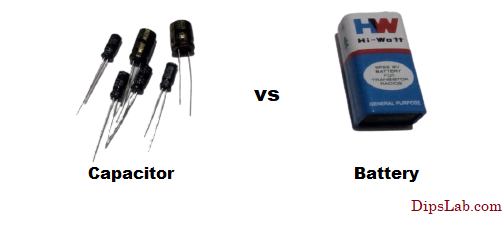
Capacitors and batteries are electronic devices that store and release electrical energy. The capacity of these devices is measured in terms of how much energy it stores and releases. Usually, it is calculated in an ampere-hour (Ah).
This is the basic function and similarity between capacitor and battery. But, they have some salient differences.
In this tutorial, we are going to study what is the difference between the capacitor and battery.
Difference between Capacitor and Battery

Let’s compare capacitor vs battery with their multiple specifications in tubular form.
| # | Content | Capacitor | Battery |
| 01 | Basic Principle | Capacitor works based on electrostatic field. | Battery works based on an electrochemical (or oxidation-reduction) reaction. |
| 02 | [Defination] What is a capacitor & battery? | An electronic device that stores the potential energy and releases it in the form of electric energy is called a Capacitor. Sometimes, it is called a Condenser. | The device that stores potential energy and converts it into electric energy is called a Battery. |
| 03 | Storing energy | In a capacitor, potential energy is stored in the form of an electrostatic field. | In a battery, potential energy is stored in the form of chemical energy. |
| 04 | Construction of capacitor & battery | Two or more metallic plates are required for the construction of the capacitor. | Anode (positive) and cathode (negative) terminals are required for the construction of the battery. |
| 05 | Insulating material | The dielectric material (insulator) is used in the capacitor that separates metallic plates. | The electrolyte solution is used in the battery that separates the anode and cathode terminals. |
| 06 | What are the active and passive components? | The capacitor is a passive component. | The battery is an active component as it generates electric energy. |
| 07 | Functions of charged particles (electrons). | It can only store charge particles (electrons). | It can generate and store charge particles (electrons). |
| 08 | Volatge Function | Capacitor rapidly decreases voltage while discharging. | The battery provides a constant voltage (DC source) supply. |
| 09 | Types of capacitor & battery | Capacitors are classified into different types such as Ceramic, Tantalum, and Electrolytic. | Batteries are classified into different types such as Alkaline, Lead-acid, Lithium-ion, Nickel-cadmium, Zinc-carbon. |
| 10 | Requires times | It requires less time for charging and discharging (few seconds). | It requires more time for charging and discharging (few minutes). |
| 11 | Polarity | During charging and discharging, the capacitor has the same polarity. | During charging and discharging, the battery has reversed polarity. |
| 12 | Used of capacitor & battery | The capacitor is used in electrical and electronic circuits or devices, power factor correction, electronic filter, motor starter, oscillator, snubber, etc. | The battery is used in power electronic appliances, medical devices, automatic equipment, IoT based devices, etc. |
| 13 | Capcitor & battery cost | It is cheap and affordable. Its cost depends on the size and power rating. | It is costly as compared to the capacitor. |
| 14 | Service Life | It has a long service life. | It has a short service life. |
15. Symbolic Representation of Capacitor and Inductor

In this post, I have covered 15 basic differences of capacitor and battery. If you have any queries regarding capacitor vs battery, you can ask by giving your comment below.
Read related some differences:
- Active Component vs Passive Component
- Electrical vs Electronics
- Capacitor vs Inductor
- Oscillator vs Alternator
- Motor vs Generator
- Alternating Current vs Direct Current
Thanks for Reading!
असेच एखादे संकेतस्थळ(वेबसाईट) किंवा निदान ब्लॉग तरी मराठीतून हवा.
Capacitor is stored Electric energy and battery is store in the form chemical energy to convert electric energy.